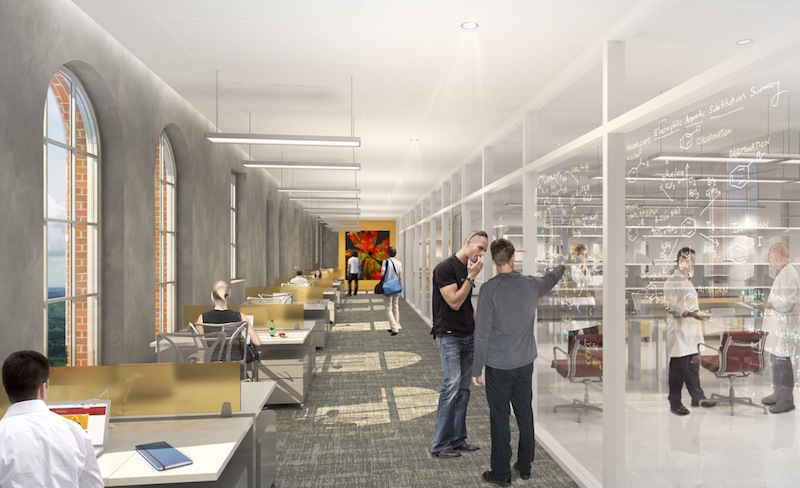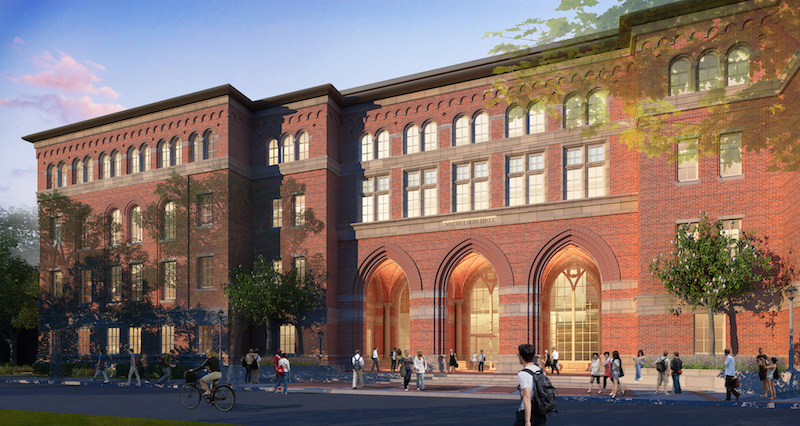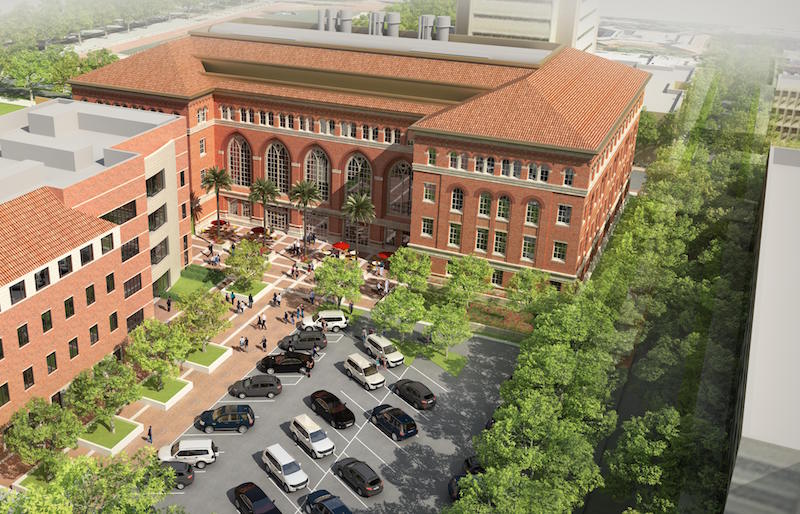The University of Southern California (USC) has scheduled a November 1 dedication ceremony for the Michelson Center for Convergent Bioscience, which at 190,000 sf is the largest academic building on the university’s Pasadena campus.
The Center will provide lab and research facilities for USC’s engineering, arts & sciences, and medical schools. The goal of the Center, according to USC, is to “fast-track detection and cure of diseases by turning biological sciences into a quantitative and predictive science.”
Over several months following the dedication, 300 people will move in. And while only 58% of the lab space has been fitted out for specific use, the infrastructure is in place and the future costs have already been accounted for the eventual fitting out of the unoccupied space, whomever the user.
More important, Michelson is designed, engineered, and constructed with an eye toward space flexibility and the accommodation of whatever equipment might need to be installed in the future, according to Alton Parks, the senior project manager. The hope, too, is that the design provokes interdisciplinary interaction.

Glass walls surround the lab spaces within the Michelson Center, so that occupants can see what their coworkers are doing. The design goal is to encourage interdisciplinary “collision.” Image: USC
HOK is this project’s Executive Architect, Vanderweil Engineers its MEP/FP engineer, and DPR is GC. Construction costs were not disclosed, but in 2014 Dr. Gary K. Michelson—an orthopedic spinal surgeon who made his fortune developing implants, surgical procedures, and instruments—and his wife, Alya, donated $50 million to fund the Center.
The barbell-shaped building has labs at both ends. Right now, the engineering school takes up most of the lab space on the third and fourth floors of the building’s south end. But many of the Center’s unoccupied labs remain unfinished—literally no ceilings, just enough HVAC to meet code—so as not to hamstring any of the schools’ recruitment efforts.
“Fitouts are kind of a shell game, because you really don’t know who’s going to move in,” explained Parks.
Budget cutbacks did not impact the building’s infrastructure, said Parks, which includes 189 miles of wiring, 1 million pounds of ductwork, and is designed for a total of 80 fume hoods.
The Center, which meets California’s Title 24 energy codes, includes an air-handling system that can deliver air over any area of the building, at whatever air-exchange rate is called for. The HVAC system also has the flexibility to service “the outer limits of machines themselves, to their maximum capacity forever,” said Parks.
The Center aggregates several departments that had been spread across campus, and is designed, said Parks, to encourage “collision” among different academic disciplines within the building.
“We needed to do something about silo-ing,” said Parks. So the central areas of the building include conferences rooms on the second and fourth floors. The third floor is dominated by a large central social space called “the living room” that has varied seating, huddle and meeting rooms, and a 22-ft-long community table in the middle. This central space is supported by a kitchen/pantry with refrigerators, vending machines, and sinks.

More than 250,000 bricks were used for the exterior facade of the Michelson Center, which also includes 312 exterior windows and doors. Image: USC
The goal, explained Parks, is to get people working within the building’s north and south wings to mingle and talk on a regular basis in the middle of the Center. There are lots of glass walls throughout, so people working in the building can see what’s going on along its north-south and east-west circulation axes. Interactive video screens adorn the west wall. “Monumental stairs” in front of the building’s entries are meant to stimulate human movement between floors.
Furniture can contribute to convergence, too, said Parks. Two people can work together at the rise-up desks throughout the building. And the Center is the first science building to install a new piece of furniture, designed by Herman Miller, which is kind of a pop-up office: The freestanding, conical module, stationed in the hallways, includes a round table, marker boards, and seating for four or five people. Its curved design dissipates sound.
“This furniture synchronizes with Michelson’s [convergent] intent,” said Parks.
Related Stories
Architects | Apr 6, 2023
Design for belonging: An introduction to inclusive design
The foundation of modern, formalized inclusive design can be traced back to the Americans with Disabilities Act (ADA) in 1990. The movement has developed beyond the simple rules outlined by ADA regulations resulting in features like mothers’ rooms, prayer rooms, and inclusive restrooms.
Sports and Recreational Facilities | Mar 30, 2023
New University of St. Thomas sports arena will support school's move to Division I athletics
The University of St. Thomas in Saint Paul, Minn., last year became the first Division III institution in the modern NCAA to transition directly to Division I. Plans for a new multipurpose sports arena on campus will support that move.
Designers | Mar 28, 2023
Inclusive design requires relearning how we read space
Pulling from his experience during a campus design workshop, David Johnson, AIA, LEED AP, encourages architects to better understand how to design spaces that are inclusive for everyone.
Healthcare Facilities | Mar 26, 2023
UC Davis Health opens new eye institute building for eye care, research, and training
UC Davis Health recently marked the opening of the new Ernest E. Tschannen Eye Institute Building and the expansion of the Ambulatory Care Center (ACC). Located in Sacramento, Calif., the Eye Center provides eye care, vision research, and training for specialists and investigators. With the new building, the Eye Center’s vision scientists can increase capacity for clinical trials by 50%.
Sports and Recreational Facilities | Mar 15, 2023
Georgia State University Convocation Center revitalizes long-neglected Atlanta neighborhood
Georgia State University’s new Convocation Center doubles the arena it replaces and is expected to give a shot in the arm to a long-neglected Atlanta neighborhood. The new 200,000 sf multi-use venue in the Summerhill area of Atlanta is the new home for the university’s men’s and women’s basketball teams and will also be used for large-scale academic and community events.
Sponsored | Cladding and Facade Systems | Mar 15, 2023
Metal cladding trends and innovations
Metal cladding is on a growth trajectory globally. This is reflected in rising demand for rainscreen cladding and architectural metal coatings. This course covers the latest trends and innovations in the metal cladding market.
Student Housing | Mar 13, 2023
University of Oklahoma, Missouri S&T add storm-safe spaces in student housing buildings for tornado protection
More universities are incorporating reinforced rooms in student housing designs to provide an extra layer of protection for students. Storm shelters have been included in recent KWK Architects-designed university projects in the Great Plains where there is a high incidence of tornadoes. Projects include Headington and Dunham Residential Colleges at the University of Oklahoma and the University Commons residential complex at Missouri S&T.
Virtual Reality | Feb 27, 2023
Surfing the Metaversity: The future of online learning?
SmithGroup's tour of the Metaversity gives us insight on bringing together physical and virtual campuses to create a cohesive institution.
University Buildings | Feb 23, 2023
Johns Hopkins shares design for new medical campus building named in honor of Henrietta Lacks
In November, Johns Hopkins University and Johns Hopkins Medicine shared the initial design plans for a campus building project named in honor of Henrietta Lacks, the Baltimore County woman whose cells have advanced medicine around the world. Diagnosed with cervical cancer, Lacks, an African-American mother of five, sought treatment at the Johns Hopkins Hospital in the early 1950s. Named HeLa cells, the cell line that began with Lacks has contributed to numerous medical breakthroughs.
Sustainability | Feb 9, 2023
University of Southern California's sustainability guidelines emphasize embodied carbon
A Buro Happold-led team recently completed work on the USC Sustainable Design & Construction Guidelines for the University of Southern California. The document sets out sustainable strategies for the design and construction of new buildings, renovations, and asset renewal projects.

















